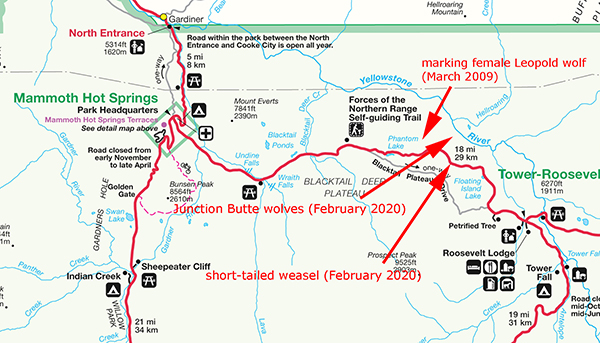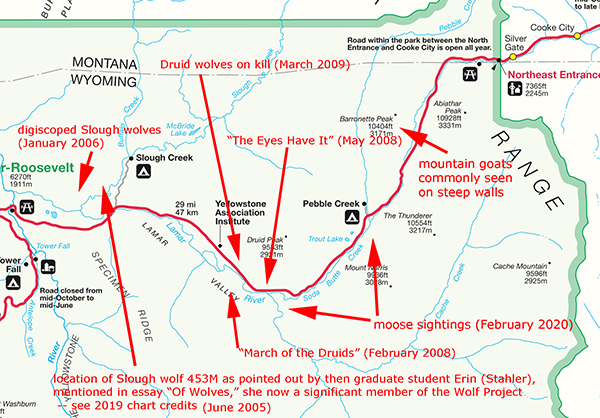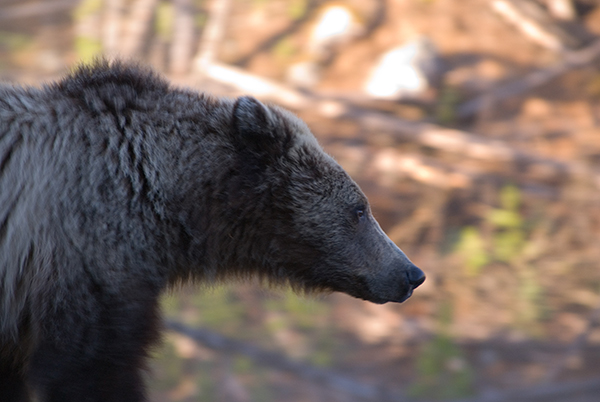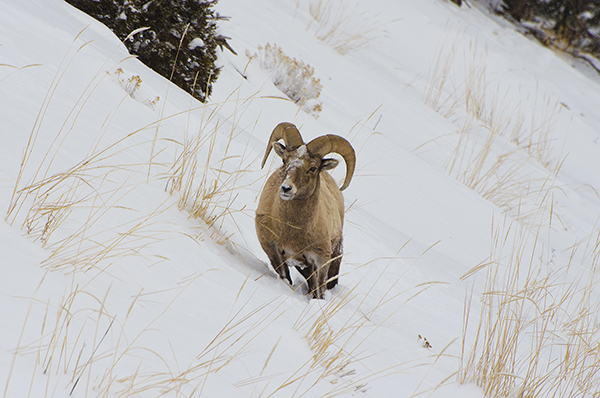YELLOWSTONE'S MEGAFAUNA -- IN THE WILD
Yellowstone's Megafauna -- In the Wild -- explores the art of locating, observing, and photographing Yellowstone National Park's exceptional wildlife through maps, conversations, essays, and the author's extensive library of on-site photographic images of the park's wild inhabitants. Included are comments on the author's philosophical approach to the subject matter as well as more practical tips involving methods, optics and camera settings, and specifics on where-to-find-what-creature, and in which season -- all contained within this easy-to-carry field guidebook.
Click on the book image below to review the entire book via a .pdf format. Instructions to purchase either the glossy softcover book or e-book appear below the .pdf link and sample essay and photograph(s).
Forward / Prologue
As I drove down the ranch road and turned right (to the west), I was thankful that the weather here at Buffalo Ranch in the Lamar Valley in February 2020 had cleared somewhat. Further, the plows had been out earlier this morning, so the road was just mildly icy and snow-packed. I was exiting the Buffalo Ranch after a four-day class taught by artist/naturalist George Bumann, The Intelligence of Animals. The fourteen-or-so participants had some classroom discussions and saw two PBS Nature documentaries featuring a guy who lived among wild turkeys and white-tailed deer. We listened to Bumann's savant-like non-practiced-but-perfect wild animal calls but mostly drove around seeking to get a glimpse of (and listen to) various wild animals. Highlights included moose in Round Prairie, eastern Lamar, and Elk Creek below the Petrified Tree turnoff (red text indicates recent information) (see maps, pages 74-75) and a wild sighting of a high-velocity short-tailed weasel (ermine, white winter stage, looked virtually clear to me against the all-white background). We observed many, many bison, all struggling to survive the intense snow and frigid conditions. Our volunteer driver and assistant-to-the-instructor Jessica had trouble at times keeping the Yellowstone Forever short bus on the snow-packed road, once even meandering off into a deep snowbank. Her error was certainly understandable, given that visibility at times was virtually zero, rendering the road, terrain, and even sky the same dull white shade. Through it all, though, we saw no wolves. Limited visibility and un-plowed overlooks certainly contributed to this unfortunate truth. But today, the first morning after the class, the situation was somewhat different. The road was still very snow-packed and slightly icy, but my rental car sported various automatic all-wheel-drive features that helped considerably. I put the vehicle in the transmission's "snow" selection and turned west toward Mammoth. Proceeding down the hill and past Slough Creek, I recalled the first time (in 2005) I had witnessed wolves in Yellowstone, and remembered with great fondness my first glimpse of wolf 453M, from the bluff (Dave's Hill) overlooking the Slough Creek Valley, wildlife locational map, see below. But alas, that pack is long gone, and recent packs are far less visible from the road. In the pre-dawn air, he and another "chaperone" wolf and two pups they were escorting even howled for us. Or so we thought. Maybe they were howling merely to celebrate the sunrise. I continued my drive through the valley bounded to the south by Specimen Ridge and the north by the Lamar River. I then passed Tower Junction, the right-of-way now bordered by the Yellowstone River, just downstream from a rugged canyoned area called Hellroaring. I proceeded up the hill past a snow-covered almost unrecognizable Floating Island Lake and beyond and headed to the previously unplowed Hellroaring overlook. As I approached, I noticed that this generally-well-used-when-available overlook was newly plowed –- further, perhaps 10-12 vehicles inhabited it –- cars, outfitter's rigs, and even a Yellowstone Forever bus. I parked just off the road and directly behind that bus. Everyone was looking intensely through a plethora of spotting 'scopes. It must be wolves. And it was! Across the steep drop-off is a cliff defined by a basalt outcropping. And just below the basalt outcropping, the Junction Butte wolf pack was moving right to left. Or at least this is what I ascertained from listening to the various wolfies (human wolf advocates; indeed they are a benign cult!) huddling near their guides and their 'scopes. I positioned myself beside a thoughtful-looking guy with a superior Swarovski 'scope and put on my best "lost-hungry-puppy–in-the-woods" face. After one of his apparent clients moved off, I asked: "Can I possibly have a look through your 'scope?" "Yes, of course." I looked and did see, in perhaps only 30 seconds of viewing, at least ten wolves, all strolling under the rock face. "It's the Junction Butte wolf pack," he stated, and then realigned himself with the 'scope's eyepiece and spoke quietly into his mic/recording device . . . "There are 14 Junction Butte wolves visible from here, so and so many grays, so and so many blacks, and so and so many pups. They are directly below the basalt cliff, moving east to west." I thought to myself just how fortunate I was to observe yet another unique wolf pack, a journey of discovery I have been on in Yellowstone really since childhood, starting initially with that lonely encounter with the black bear mother and cub in 1961 –- a continuing adventure even to this day.
Maps above indicate location of photographs that appear in the book.
To download the .pdf or order the e-book (click "related editions" and choose your platform), please access the Blurb.com website by clicking this text. To order a personally-signed copy of the book at a reduced price of $31.99, please contact me at willisg@rmi.net
[all photographic and narrative content © Willis Greiner Photography, 2020 |



